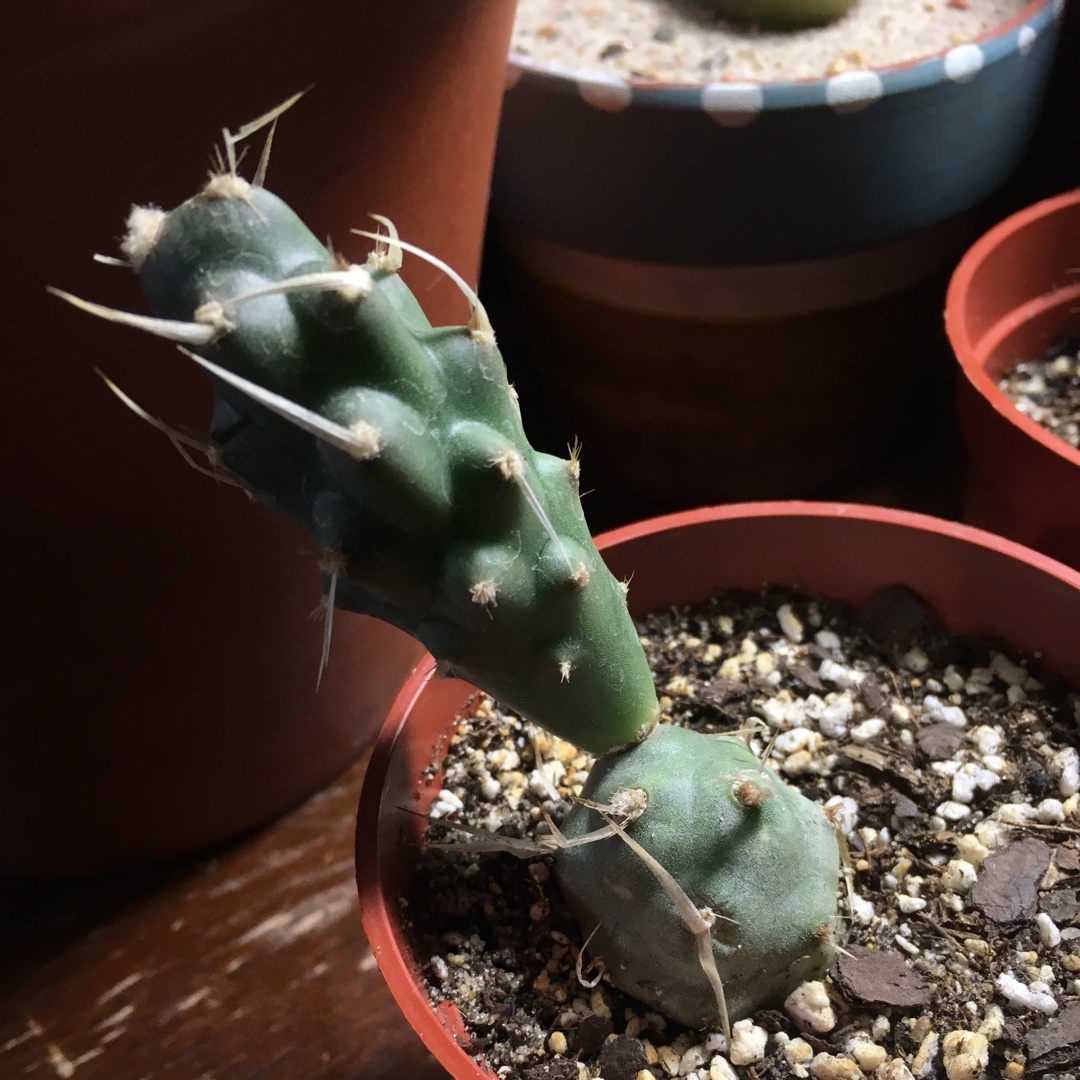
Tephrocactus articulatus 'Papyracanthus' syn. Tephrocactus articulatus var. papyracanthus
Tephrocactus 'Papyracanthus'
Tephrocactus is a small genus of Cacti in the Cactaceae family. It is native to Argentina. The stems grow round segments which resemble cylindrical, egg-shaped or spherical segments. Some species have spines, in some they are absent. The segments grow and branch. Flowers are usually white but in some species can by pink, yellow or red although they are rarely seen in cultivation and this genus is mainly grown for its stems. Most Tephrocactus are slow growers, and they are extremely well adapted to drought and able to store water within their structure to ensure survival through dry periods. They are often grown in greenhouses, particularly in regions unsuited to their cultivation outdoors. They can be grown in the ground or in suitable containers which means that they are suitable as houseplants, being tolerant of the often dry atmosphere. 'Papyracanthus' is a variety which produces segments which resemble pine cones, and has flat paper or ribbon like spines. It also produces white or yellow flowers.
Contributed by @krisbrando
-
Full sun
-
Very little water
-
A little frost hardy: 32F (0°C)
-
Light and free draining
Common name
Tephrocactus 'Papyracanthus'
Latin name
Tephrocactus articulatus 'Papyracanthus' syn. Tephrocactus articulatus var. papyracanthus
type
Cactus
family
Cactaceae
ph
5.0 - 7.0 Acid - Neutral
Plant & bloom calendar
-
Best time to plant
full grown dimensions
 0.50 M
0.50 M
0.50 M
0.50 M
Tephrocactus articulatus 'Papyracanthus' syn. Tephrocactus articulatus var. papyracanthus
Tephrocactus is a small genus of Cacti in the Cactaceae family. It is native to Argentina. The stems grow round segments which resemble cylindrical, egg-shaped or spherical segments. Some species have spines, in some they are absent. The segments grow and branch. Flowers are usually white but in some species can by pink, yellow or red although they are rarely seen in cultivation and this genus is mainly grown for its stems. Most Tephrocactus are slow growers, and they are extremely well adapted to drought and able to store water within their structure to ensure survival through dry periods. They are often grown in greenhouses, particularly in regions unsuited to their cultivation outdoors. They can be grown in the ground or in suitable containers which means that they are suitable as houseplants, being tolerant of the often dry atmosphere. 'Papyracanthus' is a variety which produces segments which resemble pine cones, and has flat paper or ribbon like spines. It also produces white or yellow flowers.
Planting Outdoors
From Early Spring TO Late Spring
Only a select few cactus will survive outside in temperate climates, because of winter rains and low temperatures. In selecting plants for use outside, one must look at the habitat from which the plant originates. It must have sun most of the day. Morning and afternoon sun is better than two o clock sun. The area should have very good drainage, this is more important in the winter than the summer. Most cactus are not killed by the cold, but when the water inside the plant freezes it expands and splits the outer layer of skin, this allows bacteria to enter the plant and kill it.
Propagate by Seed
From Early Spring TO Late Spring
Many species can also be grown from seed; Use John Innes No 1 with added grit or sand for added drainage. Sow the seed in spring. Large seed will need a covering of one to two times the depth of the size of the seed. Small fine seed should not be covered, but mix the seed with a little sand to help with an even distribution. Water with a misting bottle or a watering can with a fine rose and cover the pot with a sheet of glass or plastic bag. Keeping them at 21°C in partial shade. Allow air into the pot daily by removing glass or plastic bag and wiping off condensation. Keep moist but not overly wet. Pot on seedlings when they are big enough to handle. It can take up to 12 months for them to reach this stage.
Planting in Pots
From Early Spring TO Late Winter
Potting mixes can be made by mixing one part potting mix, one part washed sand & one part course fill (rocks, pumas, broken pots, etc.) Don`t worry too much drainage is better than not enough. When planting the cactus never dig a deep hole down in the potting mix. You want the plant to set on top of the potting mix, this allows the roots to go down to get moisture with out the plant setting in wet soil. A potted cactus will live and flower in the house if given enough light, place the plant near a bright lighted window, where it will receive light most of the day. On the patio is different place the cactus in a partly shaded area until it become accustom to the sun.
Propagate by Segments
From Early Spring TO Late Summer
Tephrocactus cacti naturally grow and form segments, and they can be propagated using these segments. The segments can be broken off and will root, although the time taken to root will depend on the conditions and the species. Once your plant has gained a decent size and has grown a number of segments, carefully remove a piece and allow it to callous over for a couple of days. Depending on the size of the cut area, a callous will form over the cut surface. Once the callous has formed, place the segment in a pot with a potting soil mixture and keep in a warm place until new roots emerge. Alternative methods of propagation, such is seed, is better for solitary growing species.



























